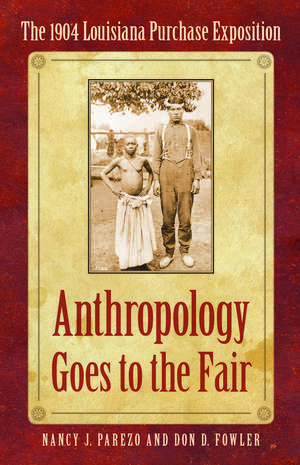Anthropology Goes to the Fair: The 1904 Louisiana Purchase Exposition: Critical Studies in the History of Anthropology
Autor Nancy J. Parezo, Don D. Fowleren Limba Engleză Paperback – iul 2009
World’s fairs and industrial expositions constituted a phenomenally successful popular culture movement during the nineteenth and twentieth centuries. In addition to the newest technological innovations, each exposition showcased commercial and cultural exhibits, entertainment concessions, national and corporate displays of wealth, and indigenous peoples from the colonial empires of the host country.
As scientists claiming specialized knowledge about indigenous peoples, especially American Indians, anthropologists used expositions to promote their quest for professional status and authority. Anthropology Goes to the Fair takes readers through the 1904 Louisiana Purchase Exposition to see how anthropology, as conceptualized by W J McGee, the first president of the American Anthropological Association, showcased itself through programs, static displays, and living exhibits for millions of people “to show each half of the world how the other half lives.” More than two thousand Native peoples negotiated and portrayed their own agendas on this world stage. The reader will see how anthropology itself was changed in the process.
| Toate formatele și edițiile | Preț | Express |
|---|---|---|
| Paperback (1) | 232.97 lei 6-8 săpt. | |
| Nebraska Paperback – iul 2009 | 232.97 lei 6-8 săpt. | |
| Hardback (1) | 411.87 lei 6-8 săpt. | |
| Nebraska – sep 2007 | 411.87 lei 6-8 săpt. |
Din seria Critical Studies in the History of Anthropology
-
 Preț: 368.09 lei
Preț: 368.09 lei -
 Preț: 217.53 lei
Preț: 217.53 lei -
 Preț: 231.34 lei
Preț: 231.34 lei - 19%
 Preț: 511.73 lei
Preț: 511.73 lei -
 Preț: 297.15 lei
Preț: 297.15 lei -
 Preț: 467.70 lei
Preț: 467.70 lei -
 Preț: 143.86 lei
Preț: 143.86 lei - 23%
 Preț: 449.27 lei
Preț: 449.27 lei -
 Preț: 221.55 lei
Preț: 221.55 lei -
 Preț: 220.78 lei
Preț: 220.78 lei - 15%
 Preț: 456.93 lei
Preț: 456.93 lei -
 Preț: 226.43 lei
Preț: 226.43 lei -
 Preț: 219.68 lei
Preț: 219.68 lei -
 Preț: 426.41 lei
Preț: 426.41 lei -
 Preț: 217.95 lei
Preț: 217.95 lei -
 Preț: 208.87 lei
Preț: 208.87 lei - 15%
 Preț: 452.35 lei
Preț: 452.35 lei -
 Preț: 361.36 lei
Preț: 361.36 lei -
 Preț: 316.70 lei
Preț: 316.70 lei -
 Preț: 508.71 lei
Preț: 508.71 lei -
 Preț: 283.08 lei
Preț: 283.08 lei -
 Preț: 432.95 lei
Preț: 432.95 lei -
 Preț: 256.70 lei
Preț: 256.70 lei - 23%
 Preț: 456.24 lei
Preț: 456.24 lei -
 Preț: 394.77 lei
Preț: 394.77 lei -
 Preț: 323.35 lei
Preț: 323.35 lei -
 Preț: 257.09 lei
Preț: 257.09 lei -
 Preț: 408.05 lei
Preț: 408.05 lei -
 Preț: 297.07 lei
Preț: 297.07 lei -
 Preț: 216.59 lei
Preț: 216.59 lei -
 Preț: 469.61 lei
Preț: 469.61 lei -
 Preț: 215.27 lei
Preț: 215.27 lei - 15%
 Preț: 488.94 lei
Preț: 488.94 lei -
 Preț: 396.77 lei
Preț: 396.77 lei -
 Preț: 479.24 lei
Preț: 479.24 lei -
 Preț: 375.78 lei
Preț: 375.78 lei - 15%
 Preț: 464.65 lei
Preț: 464.65 lei - 14%
 Preț: 501.01 lei
Preț: 501.01 lei
Preț: 232.97 lei
Nou
Puncte Express: 349
Preț estimativ în valută:
44.59€ • 46.15$ • 37.68£
44.59€ • 46.15$ • 37.68£
Carte tipărită la comandă
Livrare economică 05-19 martie
Preluare comenzi: 021 569.72.76
Specificații
ISBN-13: 9780803227965
ISBN-10: 0803227965
Pagini: 552
Ilustrații: 48 photographs, 2 maps, 10 tables, 12 appendixes, index
Dimensiuni: 152 x 229 x 36 mm
Greutate: 0.8 kg
Editura: Nebraska Paperback
Colecția University of Nebraska Press
Seria Critical Studies in the History of Anthropology
Locul publicării:United States
ISBN-10: 0803227965
Pagini: 552
Ilustrații: 48 photographs, 2 maps, 10 tables, 12 appendixes, index
Dimensiuni: 152 x 229 x 36 mm
Greutate: 0.8 kg
Editura: Nebraska Paperback
Colecția University of Nebraska Press
Seria Critical Studies in the History of Anthropology
Locul publicării:United States
Notă biografică
Nancy J. Parezo is a professor of American Indian studies and anthropology at the University of Arizona and the curator of ethnology at the Arizona State Museum. She is the editor of Hidden Scholars: Women Anthropologists and the Native American Southwest. Don D. Fowler is a professor of anthropology, emeritus, at the University of Nevada, Reno. He is the author of A Laboratory for Anthropology: Science and Romanticism in the American Southwest, 1846-1930.
Cuprins
List of Illustrations
Acknowledgments
Acknowledgments
Series Editors' Introduction
Prologue: Setting the Stage for St. Louis
Chapter 1 Organizing the Louisiana Purchase Exposition
Chapter 2 WJ McGee and the Science of Man
Chapter 3 Planning the Anthropology Department and Model Indian School
Chapter 4 Assembling the “Races of Mankind”
Chapter 5 Presenting Worthy Indians
Chapter 6 The Model Indian School
Chapter 7 The Philippine Reservation
Chapter 8 The Anthropology Villages
Chapter 9 The Polyglot Pike
Chapter 10 Being a Living Exhibit
Chapter 11 In the Anthropology Building
Chapter 12 Anthropological Performances
Chapter 13 Celebrating the Fair and Going Home
Chapter 14 The Experiences of an Exposition
Epilogue: Passing into History and Moving On
Appendix 1: McGee’s Racial Classification Schemes
Prologue: Setting the Stage for St. Louis
Chapter 1 Organizing the Louisiana Purchase Exposition
Chapter 2 WJ McGee and the Science of Man
Chapter 3 Planning the Anthropology Department and Model Indian School
Chapter 4 Assembling the “Races of Mankind”
Chapter 5 Presenting Worthy Indians
Chapter 6 The Model Indian School
Chapter 7 The Philippine Reservation
Chapter 8 The Anthropology Villages
Chapter 9 The Polyglot Pike
Chapter 10 Being a Living Exhibit
Chapter 11 In the Anthropology Building
Chapter 12 Anthropological Performances
Chapter 13 Celebrating the Fair and Going Home
Chapter 14 The Experiences of an Exposition
Epilogue: Passing into History and Moving On
Appendix 1: McGee’s Racial Classification Schemes
Appendix 2: Native Participants
Notes
References
Index
Index
Recenzii
"Fascinating details and readable style make this a compelling account of the US's last great, naive exposition of 19th-century empire building."—H. G. Kong, CHOICE
“Well organized and written. The authors have researched extensively in exposition company files, the papers of McGee and others with whom he worked (or quarreled), and the archives of the Bureau of Indian Affairs and other agencies connected with the exposition. A large body of secondary sources provides background and context. More than fifty illustrations add a visual dimension to the book.”—John E. Findling, Journal of American History
"Anthropology Goes to the Fair is a major contribution to the history of racial thought and the history of anthropology."—John David Smith, North Carolina Historical Review
"Nancy Parezo and Don Fowler's Anthropology Goes to the Fair provides a comprehensive contribution to the literature on the world fair phenomenon, focusing explicitly on the display of indigenous peoples at the Louisiana Purchase Exposition of 1904. This fascinating and well-written work accomplishes a number of new things."—Mary Neuburger, Journal of American Ethnic History
"[Anthropology Goes to the Fair] is a rollicking examination of what one might today regard as an insane enterprise. It affords valuable insight into the origins and early evolution of American anthropology, as well as an understanding of early twentieth-century social mores of the American people."—Bernard L. Fontana, Journal of Arizona History












